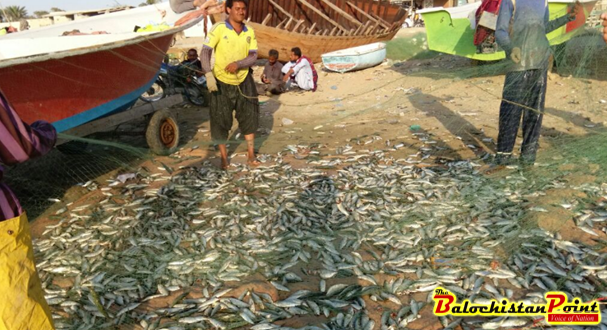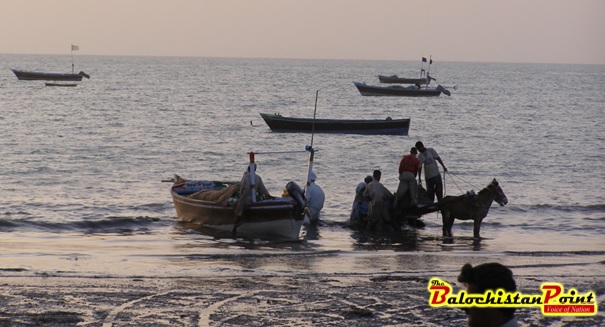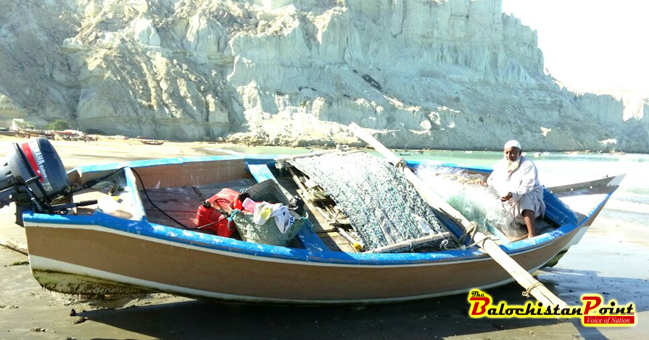By: Qazi Nisar Ahmed
Fishing is the main and major source of income and livelihood of the people of Coastal area of Balochistan since the inception of human population, centuries ago. Around 55000-60,000 people are engaged in fishing and 60% of them are on regular basis. Balochistan is bestowed with a large share of 760 km coastline alongwith 8 main and 30 smaller fish landing sites with annual potential fish catch of 300,000 tonnes. However, from the last three decades while combating the immense pressure of exports of sea food and sea food products the fish catching has been increased from Balochistan, It reached the high mark of 147,000 tonnes in 2012, which in turn increased the trend of overfishing and destructive fishing methods in the sea of Balochistan.
According to estimates more than 300 trawlers, 48 sail boats, 1698 Gill netters and 4690 Mech Sail boats are fishing day and night catching hundreds of ton of fish daily without limitation or any quota, causing great depletion of the fishery stock. It was echoing that due to illegal fishing and other means of overfishing the livelihood and socio-economic development of local and ground fishermen has greatly decreased and affected their lives accordingly. The fishermen community time to time recorded protest while finding themselves in trepidation due to mal-practices of fishing, massive trawling and other instruments of overfishing, which are responsible for the dwarfism of fishry stock. Keeping in view above reservations of ground fishermen, it was decided that a survey should be conducted to chalk out that how much fishery stock has reduced and what impacts it has created on the socio-economic conditions of local fishermen/population.
According to estimates more than 300 trawlers, 48 sail boats, 1698 Gill netters and 4690 Mech Sail boats are fishing day and night catching hundreds of ton of fish daily without limitation or any quota, causing great depletion of the fishery stock.
The survey was carried out by the officials of fisheries department in the respected areas of Jiwani, Gunz and Bandari, The survey asked questions that allowed inferences to be made about their income, stock abundance, factors for the cut back of fishery bank, fish condition and by-catches.
During this survey 100 fishermen were interviewed one to one and in groups as well. They reflected the horror scenario of fishery reserves, which according to majority of them has declined to 70% and just 30% stock has remaining. Out of 100 fishermen 61 fishermen told that about 70%, 26 fishermen felt that 50% while just 13 fishermen realized that 30% fishery flock has diminished. In contrast to it, the officials said that above than 60-70% stock has remaining. The statistics are not toothsome from Sindh fisheries department as well. According to media reports, on 21 April, 2010 the director general of marine fisheries reported that sea food catching had declined by 29% over the last decade. This reduction of fishery stock has directly lacerated the socio-economic conditions of the vulnerable fishermen of Balochistan. while reponsding to a question about their income, about 40% replied that their income has reduced to 50%, and 50% of fishermen responded that their income has increased (Note: most of fishermen being illiterate, had no idea what and how to answer and this fact was difficult for the survey team to extract the real answer) and their social life and education of their child greatly affected Some of fishermen are economically so miserable that they are hardly living from hand to mouth.
The squalor of fishery stock mainly due to over-fishing and Philistine-practices of fishing has saboteurs the marine flora and fauna and the number of fish species have alarmingly reduced meagerly due to by-catches as well. Even, according to some of the fishermen almost all the prevailing species are threatened. Beside this, its a common practice that majority of fishermen go for fishing during breeding months and they are using minimum mesh size net catching even the smallest size of fishes, fishermen are practicing the old and Traditional techniques of fishing which are other important factors of fishery haft reduction.
Now, it’s the high time for expiation and it is an essential ingredient of our responsibility to exhibit commiserate and effectuate joint efforts to rescue the suffocated fishery stock. However, the Provincial high authorities of fisheries department are taking actions against inconveniences and playing active role for the development of fisheries sector, the previous budget of 2015-16 shows 30% increase in fisheries budget which is sign of their interest and devotion.
It is hereby, strongly suggested that the liberalization of licenses should be checked, massive trawling, bottom trawling and other methods of destructive fishing,prohibited structured net and mesh size should be hampered,Ban required to be imposed on fishing during breeding months, steps need to be taken for restoration of threatened species, Marine Aqua culture call to be design & promoted, Designing of quota for each species and for each trip, Demarcation for new marine protected areas, Preservation & restoration of Mangroves & coral reefs,Necessary training about modern fishing tools and techniques and provision of modern and life saving equipment for fishermen and allocation of Funds for the old or financially weak fishermen should be formulate to prep up their lives.
If genuine issues were addressed seriously, good suggestions were appreciated and welcome steps were taken than surely, it will prove a boost for the revival of fishery stock and an emblem for the socio-economic development of poverty striken fishermen.
The writer is Senior Marine Biologist.
Published in The Balochistan Point on August 21, 2017
 Balochistan Point Voice of Nation
Balochistan Point Voice of Nation






